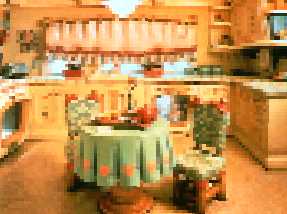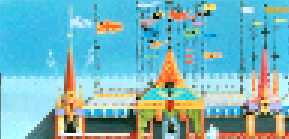This Happy Place (The Architecture of Reassurance: Designing the Disney Theme Parks)
 One of the most beloved experiences of Americans is visiting their other national capital, Disneyland. But, can it be a model for urban design? This exhibition slips this and other questions in between original promotional watercolours and various charming historica from the Disney team archives, documenting the emergence of the Disney territories from California through to Tokyo.
One of the most beloved experiences of Americans is visiting their other national capital, Disneyland. But, can it be a model for urban design? This exhibition slips this and other questions in between original promotional watercolours and various charming historica from the Disney team archives, documenting the emergence of the Disney territories from California through to Tokyo.
As its subtitle - A THOUGHT-PROVOKING Look at the Planning and Construction Behind the MAGIC - illustrates, the exhibition is a little vague as to whether it wants to be critical. It's a small, small yet terribly sensitive Disney spot in the American heart, to whit: when Disneyland opened in 1955, critics accused Walt himself of, "callously commercialising characters that were already embedded in the imaginations of most Americans". In the 1950s ABC TV financed construction of the original Disneyland in California. In return Walt agreed to host a weekly 'Disneyland' show on the channel which, in its turn, created a public already eager to visit the park. In Disneyland's layout of multiple world-choices, its viewer-visitors could repeat their familiar channel-flicking behaviour: Adventureland, Tomorrowland, Frontierland.
In the 1950s ABC TV financed construction of the original Disneyland in California. In return Walt agreed to host a weekly 'Disneyland' show on the channel which, in its turn, created a public already eager to visit the park. In Disneyland's layout of multiple world-choices, its viewer-visitors could repeat their familiar channel-flicking behaviour: Adventureland, Tomorrowland, Frontierland.
Disneyland's civic planners worked without reference to the actual site (an orange grove) concentrating instead on the park's internal spatial coherence. You can't see out - Walt terminated the views at the ends of all the major streets - which suggests certain parallels to prison architecture (and, there's only one entrance!!). Potentially an interesting focus for the exhibition. Not taken up though.
Further rooms reveal more intriguing historic documents. A castle contour sketch superimposes the relative heights of fairycastle castles: California/Florida/Paris/Tokyo. Tense issues in exporting the magic are exposed, eg the 'outquainting' problem: "it was hard to out-quaint Europe".
And amongst many inconclusive gems: a 1991 pitch for a Russian pavilion addition to Florida's EPCOT ("the Soviet Union presented a real problem for EPCOT designers") in which a marketing sketch proposes a Little Russia with red square, dacha, onion-church, apron-women dancing, and Tatlin's design for a Monument to the Communist Third International curiously inserted as a fountain.
The Architecture of Reassurance continues at the Cooper-Hewitt National Design Museum New York City until 10/1/99. Why? Because we like you.
Kate Rich:Xkaterich AT infinex.comX
Mute Books Orders
For Mute Books distribution contact Anagram Books
contact@anagrambooks.com
For online purchases visit anagrambooks.com







